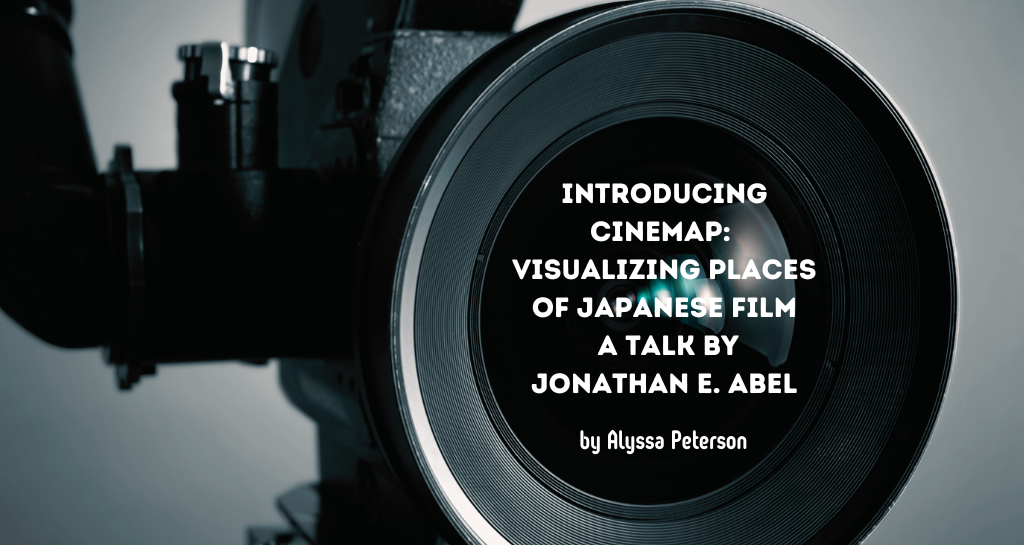
For fans of any movie or television show shot on location, there’s always a thrill when visiting, in person, the same places your favorite characters have been. Fans often share the locations in blogs or other forums, and metropolises like New York and Los Angeles have tours that take you to where famous scenes from movies and shows took place. There are even a few apps that show you the filming locations around you or at your travel destination.
The CineMAP project does something similar but is rooted in academic research and teaching. CineMAP is a database and visualization tool that Dr. Jonathan E. Abel and his colleagues from Penn State University have been working on for the past ten years. Using a variety of online sources, they have created a database of films from Japan, Germany, France, and Pennsylvania from the early twentieth century to the present.
While the database and forthcoming website give the locations for films, one of the larger goals of the project is to change the way that we think about and study film. Film studies often break down movies based on time[1]: how long a scene lasts, the number of scenes that focus on a specific topic or location, or the frequency of scene length throughout an entire film. Instead, Abel wants us to think about films in terms of space, such as breaking down how a scene is staged on screen, mapping theaters and cinemas around cities to study the reception of movies, and exploring where films are shot when on location. Pulling information from “official” sources, like production studio websites, as well as “unofficial” sources, like IMBD and prefecture film offices[2], Abel and his team have created a large database of movies that were filmed in Japan, either by Japanese studios or foreign studios filming in the country.

What can such a large database of movies tell us about Japanese films or movies filmed in Japan? In a fascinating presentation, Abel talked about three different ways to use this information to dig deeper into film. His first example focused on the role the physical location assumed for the audience. Across the thirty Godzilla movies, the buildings within the scenes played an important role in connecting the audience to the monster’s destruction. For instance, one of the theaters in which the very first movie debuted was also in the background of Godzilla’s destruction, giving an added sense of fear to moviegoers as they sat in that same theater, seemingly watching Godzilla destroying the city outside. The changing locations over time can also help to highlight the historical gaps within the movies, such as when the Diet building (which houses the national legislature) from the 1940s showed up again in a Godzilla film from the 2020s. The original Diet building no longer exists, so it was digitally recreated for the recent film – something many without background knowledge of Japan would not know, but something that would stand out when studying the filming locations.
Abel’s second example compared the locations of filmographies by three famous directors. By placing the database information on a map, scholars can study where directors chose to film and investigate any patterns that show up. This could also be expanded to explore where films were shot over time more generally, especially within larger cities that quickly expanded outwards during the twentieth century, like Tokyo. One interesting instance Abel found was that many Nikkatsu[3] films from 1955 to 1965 were shot along a specific train line. Looking closer, Abel found a common thread in the movies that tied this line, the Odakyu train line, to ideas of escaping from the modern city or to the big city. He also found a much more practical explanation: one of Nikkatsu’s studios was built at the end of the Odakyu line in 1954, making filming along the line much easier than in other locations.

Finally, historians can use the platform to do a deep dive into locations in a single film. Abel used the 1983 Japanese film Family Game to demonstrate what we could learn by looking at the various specific locations in this way. He screened some clips from the film, showing that the family lived in some industrial location in Tokyo. The first short scene tried to show that the apartment complex they lived in was a newly developed and still relatively low-income part of town, demonstrated by an escort coming home just as the son was heading off to school. Upon closer study, Abel found that the apartment building was located on a man-made island constructed in Tokyo Bay that was built up and populated in the 1980s by up-and-coming families. Today that same location is home to expensive, high-rise apartments. By examining that specific location during the early 1980s, we now know that the family in the movie would have been considered part of the rising middle class. This is something that many Japanese movie-goers at the time would likely have understood, but viewers in the 2020s would likely have missed it because the location was poorly understood and has changed so much over time.

CineMAP is still a work in progress, but its database already has a range of search abilities that will be helpful for academics when it is released to the public. With help from Wikipedia synopses, researchers can search for a single term, and all the movies that include that term in their synopsis will populate. Searches can also be conducted based on genre, keywords, cast or crew names, and the percentage of women that make up the cast. The search results will also generate a timeline with the films that meet the search criteria, so a researcher would know if a certain genre was more popular during a stretch of time or if movies with certain keywords were filmed in certain time periods. The results populate on an interactive map, which gives film information with the place marker and allows researchers to look for spatial patterns.
The platform is large and interactive, but Abel points out that the information is only as good as the sources, and some sources give better information than others. For instance, some location information is more specific than others, with some giving an exact address while others give the general name of a town or city. In the future, Abel wants to open the tool up for possible crowd-sourcing to improve the location and film information, including building an app that would allow people to use the database and interactive map while also contributing corrections and additional information. Future plans also include running movie subtitles through a “tokenizer” to pull out place names and for better systems of coding the large amounts of information that are pulled through from the various websites. For fans of film or scholars who use film in their research, CineMAP will be a valuable application for finding locations where films were shot and for exploring research questions based on possible patterns in these same locations.

A recent funding award from the Yanai Initiative at UCLA is helping CineMAP to switch platforms to create a better user interface. A conference later this year that will focus on the academics’ use of CineMAP will help Abel and his colleagues fine-tune the website for its eventual future release. Until then, it’s exciting to know that a tool like CineMAP exists and is making its way to public use. The fields of film studies, film history, and the broader field of digital humanities will surely benefit from this valuable platform.
Alyssa Peterson is the current IHS Graduate Research Assistant and a PhD Candidate in the History department. Her work focuses on the history of science, medicine, and the environment in the early modern British-Atlantic world. Her dissertation examines how British chemists and physicians used earthquakes and other natural disasters happening in Jamaica, North America, and England to better understand the composition of air over the long eighteenth century.
Jonathan E. Abel serves as an Associate Professor of Comparative Literature and Japanese Studies at Penn State University. His teaching and scholarly interests focus on questions of global modernism, literary reception, translation studies, film studies, new media, and literary and cultural theory. He was the Director of the Global and International Studies Program at Penn State from 2016-2022. He is currently Associate Director of the Center for Humanities and Information at Penn State. For the academic year 2022-2023, he was a Woodrow Wilson Center Fellow. His recent book, The New Real: Media and Mimesis in Japan from Stereographs to Emoji (University of Minnesota Press, 2023), shows how cultural products reflect, refract, and change the world through their mediations.
[1] One of the more popular software is UChicago’s Cinemetrics, which helps the user track the length of scenes.
[2] A prefecture is roughly equivalent to an American state. It is one step below the national government but above the city and town governments.
[3] One of the oldest film studios in Japan and one of the largest in the country today.
_________________________________________________________________________________________
The views and opinions expressed in this article or video are those of the individual author(s) or presenter(s) and do not necessarily reflect the policy or views of the editors at Not Even Past, the UT Department of History, the University of Texas at Austin, or the UT System Board of Regents. Not Even Past is an online public history magazine rather than a peer-reviewed academic journal. While we make efforts to ensure that factual information in articles was obtained from reliable sources, Not Even Past is not responsible for any errors or omissions.



